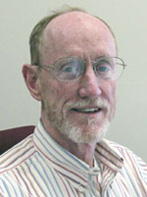ShermanLewis Faculty Profile

Sherman Lewis
Current Activities and Focus Areas:
- College Heights, a proposed, large, sustainable neighborhood near the CSUEB Hayward campus. College Heights would be located north of Carlos Bee Blvd. and Overlook Ave. on about 30 acres of mostly undeveloped land. It would have over 700 units, ranging from studio condominiums to five-bedroom townhouses, and 732 parking spaces in a parking podium under the walking area. Personal vehicles are barred from the walking area; access is by walkways. The longest walk to the Village Center is less than five minutes. The Village Center has a community center, store, café, small park, and busway. The project owns its own shuttle service, which residents ride free. It would run every ten minutes most of the day, two minutes up to the campus, six minutes down to Hayward BART. www.collegehts.org.
- A Shuttle bus service that runs most of the day, free for student use, every ten minutes, from the CSUEB Hayward campus to BART. The shuttle would replace a parking structure proposed for the campus. The Hayward Area Planning Association litigated against this structure and stopped it. The shuttle can be financed by parking fees. The shuttle can provide more access, and do it sustainably, while reducing traffic.
- A website comparing the US to the Advanced Democracies:https://internationalcomparisons.org/
This site seeks to be the most efficient and comprehensive of all sites on the web for researching international comparisons.
Developed with help from CSUEB graduates, the site has statistics evaluating national performance for the United States and eleven advanced democracies on child welfare, competitiveness, crime, economy, environment, gender equality, greenhouse gases, health, housing, human development, income distribution, international aid, military, population, rule of law, sexual health, technology, teen pregnancy, transportation, treaties, voting, and work and leisure. It includes sources, links to related articles, notes, and options to contact us via email. The site is continually updated. - The downtown Hayward Loop. The loop is the one way traffic pattern up foothill, west on A St., and south on Mission back to the Foothill, Mission, Jackson intersection. It was controversial when approved, dysfunctional in a dozen plus different ways which HAPA informed people about, and has become thoroughly opposed by everyone. In Spring 2023, I help kickstart the Council to do something, and at their priority-setting retreat the Council made it the city’s top public works priority. And has done nothing. Using data from the Alameda County Congestion Management Agency, my research showed a traffic circle would work. Now I am using DesignCAD to plan more details and make a cost estimate to show that construction can be financed by the AB1387 Special Fund for Local Agency Transportation Improvement Program projects in central Alameda County. Difficult politics lie ahead. More can be done for downtown Hayward. Contact me. https://hapaforhayward.org/
- For decades I have been trying to get the campus to remove three very old auto wrecks on sloped woods in Garin Woods, an area on the south side of the campus. No one seems to know how to do it. Then I connected with Hayward’s Fire Chief, and he has the competence and commitment to make it happen. East Bay Parks manages a nice trail from Garin Park to the campus but has refused to put it on their maps. I am publishing the idea to students who use the Recreation and Wellness Center in hopes of getting more use. More can be done for sustainability on campus. Contact me if interested.
Links
Not teaching this semester.